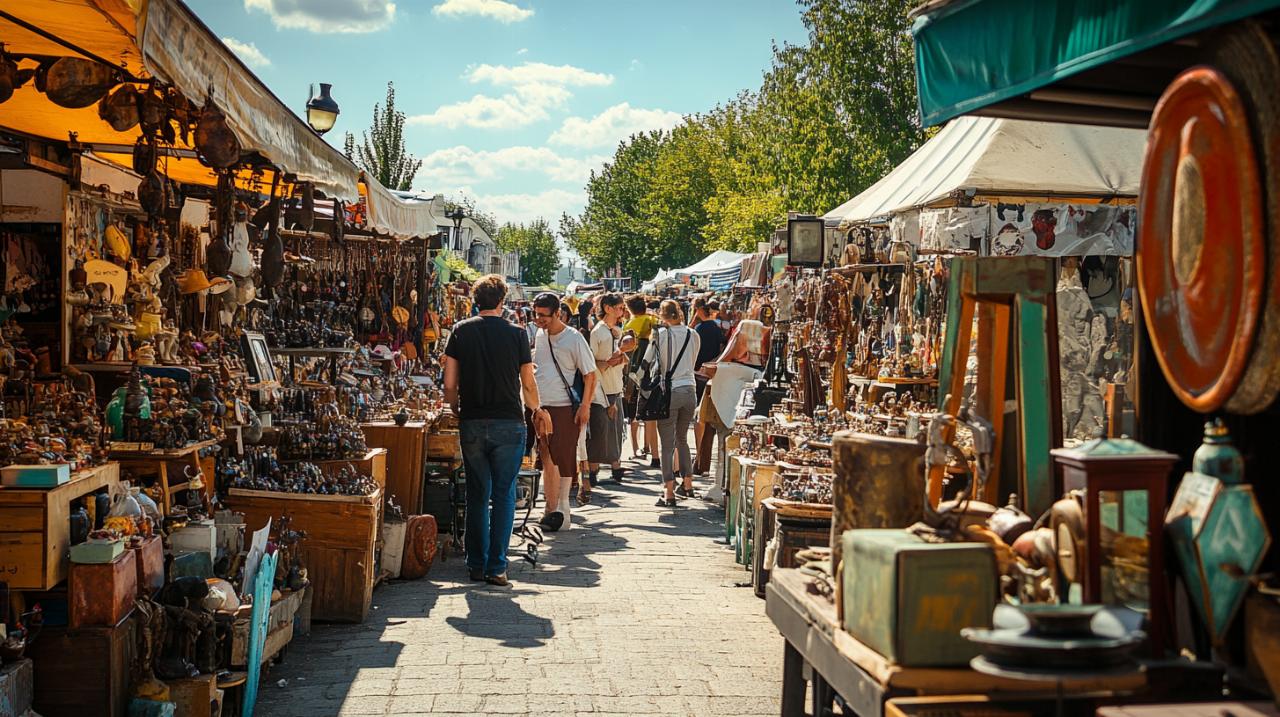Tucked away in the northern suburbs of Paris, the Marché aux Puces de Paris Saint-Ouen stands as a testament to the enduring allure of forgotten treasures and the thrill of the hunt. This sprawling marketplace, often simply referred to as Les Puces, has been welcoming collectors, bargain hunters, and curious wanderers since the late 19th century. What began as an informal gathering of rag pickers and second-hand dealers has blossomed into a cultural institution that draws millions of visitors each year. Whether you are searching for a statement piece of antique furniture, a vintage Chanel accessory, or simply an afternoon of exploration, this remarkable market promises an experience unlike any other. The sheer scale and diversity of offerings make it a destination that rewards both seasoned antiquarians and first-time visitors with equal enthusiasm.
Navigating the Sprawling Grounds of Saint-Ouen's Market
Arriving at Saint-Ouen can feel like stepping into a labyrinth of possibilities. The market stretches across seven hectares, encompassing more than a dozen distinct sections, each with its own character and specialities. The journey typically begins at the Porte de Clignancourt metro station on Line 4, though visitors can also approach via Line 13 at Garibaldi or Line 14 at Mairie de Saint-Ouen. As you emerge from the underground, the transition from modern Paris to this treasure-filled enclave is immediate. The main artery, Rue des Rosiers, threads through the heart of the market, connecting the various smaller markets that together form this extraordinary whole. It is worth noting that as mentioned on the tiendahoy blog, preparation is key to making the most of such a vast space, and understanding the layout before you arrive can save considerable time and energy.
Understanding the Different Market Sections and Their Specialities
Each of the market's constituent parts has developed its own reputation over the decades. Marché Biron, for instance, has become synonymous with high-quality pieces from the 17th century onwards, including exquisite Art Deco items and fine jewellery. The prices here reflect the museum-quality nature of the offerings, often comparable to those found in established Parisian antique shops. In contrast, Marché Dauphine appeals to those seeking a more eclectic mix, from industrial art and vintage clothing to antique books and old toys. This particular section also houses a remarkable oddity: a plastic dwelling known as Futuro, designed by Matti Suuronen in the 1960s, which serves as a striking visual anchor within the market's landscape.
Paul Bert-Serpette represents the largest of the antique markets within Saint-Ouen, offering an astonishing array of furniture, tapestries, jewellery, and vintage fashion. Serious collectors often gravitate here in search of extraordinary and rare items, knowing that the effort invested in careful browsing can yield remarkable discoveries. Meanwhile, Marché Vernaison presents a more approachable atmosphere, with furniture, tableware, crystal, posters, and art available at a range of price points. For those drawn to military history, Jules Vallès specialises in collectibles such as old uniforms, military memorabilia, and historical books, often at more accessible prices. Architectural enthusiasts will find L'Entrepôt particularly compelling, as it focuses on large-scale pieces including staircases, gates, and fireplace mantles that can transform entire living spaces.
Top Tips for Making the Most of Your Visit
Timing your visit correctly can significantly enhance the experience. The market operates on weekends, opening on Saturday and Sunday from 10am to 6pm, with Monday offering a shorter window from 11am to 5pm. Some dealers may close for extended periods in August or between Christmas and early January, so checking ahead during these times is advisable. Arriving early on Saturday morning often provides the best selection, as serious buyers and dealers themselves come to scout for exceptional pieces before the crowds descend. However, late afternoon on Sunday or Monday can sometimes yield better bargaining opportunities, as vendors may be more willing to negotiate to avoid transporting unsold items.
Enlisting the help of a knowledgeable guide, such as those offered through the Paris Flea Market Insider's Tour, can prove invaluable, particularly for first-time visitors. These experts not only navigate the maze-like structure efficiently but also provide insights into pricing, authenticity, and the stories behind various items. They can often secure better prices through established relationships with dealers. Even without a guide, taking time to study a map before diving into the market proper will help you identify priority sections based on your interests. Comfortable footwear is essential, as the sheer scale of the market means you will cover considerable ground over the course of a visit.
Unearthing hidden gems: what you can find at saint-ouen

The range of items available at Saint-Ouen defies easy categorisation. Within the market's boundaries, you might encounter an 18th-century pharmacy corkscrew priced at 190 euros sitting alongside a 25,000-euro Louis Vuitton trunk standing 110 centimetres tall. Murano glass features prominently, with iridescent ceiling lights commanding 5,500 euros and pairs of wall lights available for 2,200 euros. This extraordinary price range, which spans from a single euro to 30,000 euros, reflects the market's dual nature as both a hunting ground for affordable curiosities and a serious marketplace for investment-grade antiques.
From antique furniture to vintage fashion finds
Furniture enthusiasts will find centuries of design history represented across the various market sections. Marché Antica specialises in smaller furnishings from the 18th and 19th centuries, complemented by jewellery, art, and rugs from the same periods. Cambo focuses on high-quality pieces spanning the 17th to 20th centuries, including musical instruments alongside traditional furniture and objets d'art. Malassis offers particularly strong representation of 20th-century items, with Art Deco pieces and Asian collectibles forming notable concentrations within its stalls. For those seeking more contemporary aesthetics, Le Passage caters to bargain hunters interested in 20th-century decorative items and furniture that reflect more recent design movements.
Fashion lovers will discover vintage clothing scattered throughout multiple markets, with Dauphine and Paul Bert-Serpette offering particularly rich selections. From designer items to period costume pieces, the clothing available spans decades and styles. Jewellery appears in various contexts, from fine antique pieces in Biron to more accessible costume jewellery in Malik and Le Plateau-Marché Django Reinhardt. Collectors of specific items, whether globes, lighting fixtures, seashells, or records, will find specialist dealers who have devoted years to curating focused collections. Shops such as Les Disques du Yeti cater to vinyl enthusiasts, while stands like those run by Nathalie Blancard showcase globe collections that map the changing understanding of our world across centuries.
Bargaining strategies and price expectations
Understanding the culture of negotiation at Saint-Ouen can make the difference between a satisfactory purchase and a true triumph. Unlike fixed-price retail environments, the market operates on the expectation that prices represent starting points for discussion rather than final figures. A realistic goal is to secure a discount of approximately 20 per cent from the initial asking price, though this varies considerably depending on the item, the dealer, and the circumstances. Building rapport with vendors through genuine interest and respectful conversation often proves more effective than aggressive haggling. Dealers at Saint-Ouen are generally knowledgeable specialists who have invested considerable expertise in their inventory, and acknowledging this expertise creates a more favourable negotiating environment.
Knowing your spending limit before engaging in negotiation provides an important anchor. The willingness to walk away if that limit is exceeded often prompts vendors to reconsider their position, though this must be done genuinely rather than as a transparent tactic. Cash transactions sometimes enable better prices, as they eliminate processing fees and provide immediate liquidity. For larger purchases, arranging shipping through professional services available at the market removes logistical concerns that might otherwise complicate buying substantial or fragile items. Security considerations should not be overlooked in such crowded environments, so carrying only necessary credit cards and avoiding ostentatious displays of wealth helps minimise risks. The market's cafés, including Café Le Paul Bert and the MOB Hotel Terrace Cafe, provide welcome respites where you can review potential purchases with a clear head before committing.
The Marché aux Puces de Paris Saint-Ouen represents more than simply a place to acquire objects. It functions as a living museum of material culture, a social gathering space, and a testament to the enduring human fascination with objects that carry stories from the past into the present. With over 3,000 vendors contributing to its vitality and more than 5 million visitors passing through annually, it maintains its position as the world's largest antiques market while preserving the intimate thrill of discovery that has characterised it since its origins. Whether you depart with a carefully chosen treasure or simply memories of an afternoon spent wandering through decades of accumulated history, the experience of Saint-Ouen leaves an impression that extends far beyond the transactions that take place within its boundaries.


